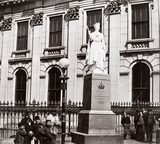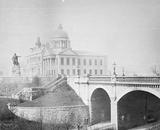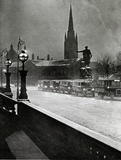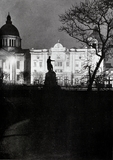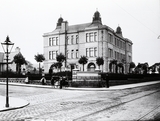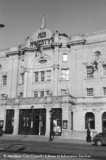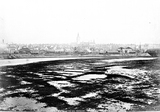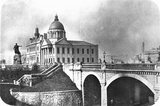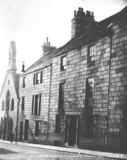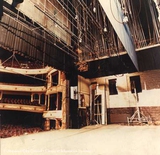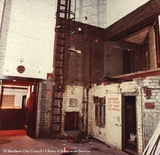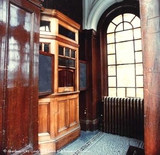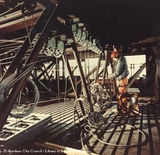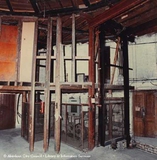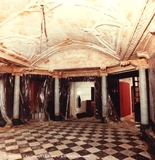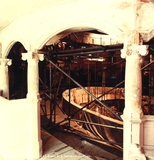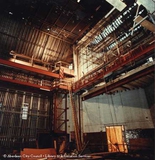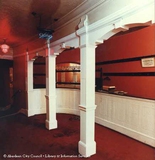|
Quick Search
|
Search Results
You searched for: More Like: 'His Majesty's Theatre renovations'
185 items
items as
Statue of Queen Victoria
73 A photograph showing the statue of Queen Victoria at the junction of Union Street and St. Nicholas Street. The building in the background is the Clydesdale Bank that stands next to M&S today. This fine Italian renaissance style building was originally constructed for the Town and County Bank and opened for business in May 1863.
The statue of Queen Victoria was made from marble and was sculpted by Banff born Alexander Brodie (c.1829 - 1867). The origin of this statue is closely related to another Aberdeen monument, the 1863 memorial statue of Prince Albert by Baron Marochetti, now standing, or rather sitting, in the area in front of the Central Library.
Marochetti's statue was augurated by Queen Victoria herself on 13th October 1863 and this was said to the first time the Queen had appeared at a public demonstration following the death of Albert in 1861. The Marochetti statue was the subject of great local controversy and there were various plans for an alternative, superior, memorial to the late Prince Consort. It was at a related meeting that a chap called Alexander Donald, from the Royal Tradesman of Aberdeen, moved "That a colossal statue in marble, of Her Majesty, be erected at the corner of St. Nicholas Street."
The endeavour was taken on by a variety of prominent citizens and funding was raised by public subscription. Brodie, the selected sculptor, worked on an 11-ton block of Sicilian marble for two years to complete the statue. The finished piece is 8 foot 6 inches in height and, at the request of Queen herself, depicts Victoria in Scottish regal attire. The statue stands on a substantial plinth of pink Peterhead granite.
The statue was unveiled and inaugurated on 20th September 1866 by Albert-Edward Prince of Wales, later to be King Edward VII and the subject of another of Aberdeen's notable statues. During his speech at the ceremony, the Prince said "Gentlemen, it has afforded me the greatest satisfaction to attend here today, by the wish of Her Majesty, and at your invitation, for the purpose of inaugurating a statue of the Queen, my dear mother. Her Majesty has desired me to express to you how much she appreciates the motives which have led the people of Aberdeenshire to give this lasting evidence of their attachment and loyalty to her person, of which she has so many proofs, and whose sympathy in her great sorrow has touched her so deeply."
During his visit, the Prince of Wales also received the Freedom of the City and attended the Royal Horticultural Society's Autumn Show, which was then going on in the Music Hall. An extensive account of the unveiling, the Royal visit and the town's celebrations is given in the Aberdeen Journal of 26th September 1866.
After some time at this location, the statue's marble began to show weathering due to the frost and so it was moved to the vestibule of the Town House in 1888, where it remains to this day. It stands at the foot of the building's splendid main stairway. The plaster model of Brodie's statue has also been on display in the Music Hall for many years.
A new bronze statue of an older Victoria, by sculptor Charles Bell Birch, was erected at the St. Nicholas Street location on 9th November 1893 and "the Queen" became a regular meeting place for generations of Aberdonians. To make way for the extension of Marks & Spencer, the 1893 statue moved to its current site at Queen's Cross on 22nd January 1964. Victoria now stands looking east towards Balmoral. Rosemount Viaduct
134 Rosemount Viaduct, showing the William Wallace statue, the South Church and the Central Library, c.1900 prior to the building of His Majesty's Theatre. Rosemount Viaduct
154 Union Terrace looking towards Rosemount Viaduct. On the left is St. Mark's Church and on the right His Majesty's Theatre. In front of the theatre is the statue of William Wallace with Prince Albert at the left. Rosemount Viaduct
217 Rosemount Viaduct looking towards the Triple Kirks and the statue of William Wallace. The row of buses are probably waiting for a performance at His Majesty's Theatre to finish. Rosemount Viaduct at night
239 The illuminated facade of His Majesty's Theatre and St. Mark's Church from Union Terrace Gardens. Guild Street
399 Guild Street looking towards the harbour.
On the left hand side of the road is the facade of Her Majesty's Theatre built in 1872. It was renamed the Tivoli in 1910. It was a popular theatre and many well-known performers appeared on its stage including W. C. Fields, Tony Hancock and Andy Stewart.
The Tivoli became a bingo hall in 1966 and finally closed its doors in 1997. However, following refurbishment, the Tivoli reopened in 2013.
The Criterion Bar is on the left of the photograph and the old Goods Station is on the right. Rosemount Viaduct, Aberdeen
413 View of His Majesty's Theatre, Rosemount Viaduct, Aberdeen. Note the Wallace Statue on the left. Kittybrewster School
458 The school was opened 14th August 1899 on Great Northern Road with space for 1,100 eager to learn pupils!
This photographs shows the school, and the junction with Lilybank Place, looking north west from Great Northern Road.
The school was built by a popular Aberdeen builder named John Morgan who amongst other things also built the Caledonian Hotel, King Street School, various churches and the statue of William Wallace which stands opposite His Majesty's Theatre.
In the early days, students would have had to learn in a building with no heating and only outdoor toilets. His Majesty's Theatre on Rosemount Viaduct, Aberdeen
476 His Majesty's Theatre on Rosemount Viaduct, Aberdeen. c.1999. Old channel of the River Dee
505 The old channel of the River Dee. After years of discussion about the development of the harbour, the Aberdeen Harbour Act of 1868 allowed the Harbour Commissioners to divert the river to the south. The first turf was cut by Lord Provost Leslie on 22nd December 1869. Union Terrace Gardens and the Denburn
692 This view taken about 1884 shows the railway line which runs north from the Joint Station through the Denburn Valley.
The Denburn ran as an open burn throughout this area with bleaching greens next to it, until the railway was constructed in 1865-7, when the burn was covered over and the greens removed.
In the late 1870's, Union Terrace Gardens was laid out next to the railway, and it was sometimes referred to as the 'Trainie Park'. The bandstand has long since been removed.
The iron footbridge on granite supports which allowed access across the gardens from Schoolhill to Union Terrace was replaced by Schoolhill Viaduct in 1886/7. This created a site for His Majesty's Theatre, South UF Church, and Aberdeen Public Library. Rosemount Viaduct
803 Rosemount Viaduct from Union Terrace Gardens. St. Mark's Church and the Central Library are on the left with the statue of William Wallace pointing towards the site of His Majesty's Theatre. Marischal Street
818 In 1766, the Town Council of Aberdeen acquired a property known as the Earl Marischal's Lodging which had laid unoccupied for a number of years. It was then demolished to allow a street to be built to create improved access between the harbour and the Castlegate. It was named Marischal Street in his honour.
This view of the west side shows the properties at No 46 and 48 and an adjacent church. William Kennedy (1759-1836), advocate, lived in No. 46, where he wrote his two volume history of the city - Annals of Aberdeen.
Next door at No. 48 was the home of Dr William Dyce, father of the eminent artist William Dyce (1806-1864). Both of these properties have now been converted into flats.
The church shown on the left was built in 1881 on the site of the Theatre Royal built in 1795. It closed as a theatre in 1872 prior to the opening of Her Majesty's Theatre and Opera House (Tivoli) in Guild Street. This building is now occupied by the Elim Pentecostal Church. Bydand Motor Transport Co. Ltd
1051 Bydand Motor Transport Co. Ltd. were one of a number of small bus companies which sprang up in the 1920's, and were based at the Western Garage on Great Western Road, Aberdeen. Many service men had learned to drive in the army during the First World War, and vehicle manufacturers were keen to supply new markets. Bydand announced in the 'Aberdeen Press and Journal' on 23rd May 1925 that they were to introduce a 'Deeside Motor Bus Service'. They offered a regular weekday half hourly service of buses between Aberdeen (Wallace Statue) and Bieldside with less frequent late buses and a Sunday service between Mannofield and Bieldside only. Buses were also to run between Aberdeen, Culter and Banchory. The fare from Aberdeen to Bieldside was 4p; Aberdeen to Culter was 8p; Aberdeen to Banchory was 1 shilling and sixpence. Within a few weeks, Bydand were extoling the virtues of their service in an advert headed 'Safety First'. The company made much of the fact that their buses started from His Majesty's Theatre and passed other theatres enroute. It was even possible to reserve a seat on the Banchory Bus when booking seats at His Majesty's Theatre. During the summer months Sunday Mystery Tours were advertised - a 60-70 mile trip for 5 shillings return. The 1930 Road Traffic Act introduced various restrictions and many small companies were taken over by the expanding company of W. Alexander and Sons Ltd. The 13 Bydand buses were transferred on 3rd October 1932. Dunecht Smiddy
1146 Blacksmiths in the smiddy at Dunecht. This shop appears to have been fairly busy, employing as it did, 3 blacksmiths. They were called upon for all sorts of metal related jobs. All the tools of the trade can be noted, including 2 anvils for hammering and a main furnace (centre of picture). All 3 blacksmiths are seen here wearing leather aprons, which protected them from the hot flying sparks. No industrial glasses were in use however at this time, and the traditional flat bonnet is still the norm.
Correspondent David Christie has identified the blacksmith on the left as James Stephenson Smith, his great grandfather. David explains that Smith worked as a blacksmith for Dunecht Estate from 1925 to 1929 and so this dates the photograph to this period. His great grandfather also worked at other properties belonging to the estate, such as renovations of Dunnottar Castle. Smith had to give up working as a Blacksmith after breaking his leg in a fall while working there.
He subsequently worked as a driver for the Dunecht Garage, which ran buses at the time, and later for the W. Alexander & Sons bus operating firm.
There is an article about this image by Hilary Simpson in the Evening Express of 17 September 1986. It details the memories of readers Margaret Skene and John Gray. Margaret's grandfather was Alexander Innes, the figure in the middle. On the right is Bill Innes, a son of Alexander. They are said to have run the smiddy with the assistance of James Smith.
The article also explains that the image was originally a postcard. One of a series detailing the various trades active on the Dunecht estate of Lord Cowdray.
(Many thanks to David for getting in touch and providing additional information and making us aware of the newspaper article.) His Majesty's Theatre renovations
1154 The stage of His Majesty's Theatre, Aberdeen showing the op fly floor and hemp lines. This photograph was taken just prior to closure for renovation. His Majesty's Theatre renovations
1155 The prompt corner at His Majesty's Theatre during renovations. His Majesty's Theatre renovations
1156 The PayBox in the foyer of His Majesty's during the renovations. His Majesty's Theatre renovations
1157 The new grid being installed at His Majesty's Theatre, Aberdeen. His Majesty's Theatre renovations
1158 The base of the old revolving stage at His Majesty's Theatre, prior to renovation. The revolve still exists, but has been covered over by the management. His Majesty's Theatre renovations
1160 The Dress Circle at His Majesty's Theatre during renovations. His Majesty's Theatre renovations
1161 The stage and new grid at His Majesty's Theatre during renovations. His Majesty's Theatre renovations
1162 The old cloak room area at His Majesty's Theatre, Aberdeen prior to renovations. |



